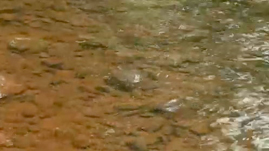Teachers' Domain - Digital Media for the Classroom and Professional Development
User: Preview


Funded in part by a grant from the U.S. Environmental Protection Agency under the Clean Water Act through the Kentucky Division of Water to the University of Louisville.
Special thanks to the Bernheim Forest and the Kentucky Division of Abandoned Mine Lands for their assistance.
In this video, a biologist visits Lower Rock Creek in Pulaski County, Kentucky to show how acid mine drainage remediation has increased the stream’s pH from acidic levels almost to 7, which is neutral. Many fish species such as minnows, trout, and bass have returned to Rock Creek. However, the remediation has not completely reversed the damage from acid mine drainage, plus non-point-source pollution from nearby roads and other building sites continue to affect the stream’s health and limit its wildlife population.
This resource is part of the Water Solutions collection.
The presence of coal beds in the rock and soil of Kentucky has had both an economical and environmental impact in our state. One of the biggest impacts has been on the quality of our water. Not only has the extraction of coal introduced large amounts of silt into streambeds, but coal mining has also introduced ions (ionized metals and salts) into our watersheds, a process which has lowered the water’s pH and led to the deposit of sediments with toxic levels of heavy metals.
Coal is a sedimentary rock formed from dead plants and trees that fell into shallow bodies of water that existed in Kentucky in earlier geological periods. Many of these shallow seas were brackish (slightly salty), resulting in the introduction of sulfur into the layers of organic matter. Since the organic matter was under water with no supply of oxygen, its decomposition was slowed tremendously. Over time, as more sediment was laid down with increased pressure, the water was removed from the organic material, and eventually coal beds containing iron II persulfide or pyrite (FeS2) were formed.
When pyrite is exposed to oxygen (in air or water), the ferrous ions are oxidized to ferric ions (Fe+2 to Fe+3), and the sulfur becomes sulfate ions (SO4-2). When dissolved into water, sulfate ions increase the amount of hydrogen ions created from the dissociation of water molecules. It is the increase of hydrogen ion concentration that lowers the pH of a solution and creates the acid mine drainage that flows into our watersheds and adversely affects the organisms that live there.
Water is known as the universal solvent because it will dissolve almost anything. Its structure as a polar compound (a molecule having slightly opposite charges) enhances its ability to dissolve particles that are charged (ions). As water runs across, through, and over rocks, soil, and organic matter, material is dissolved into that water. Other factors such as temperature, surface area, and pH can affect the solubility of solids into water.
The presence of acid mine drainage is signaled by the slightly reddish color of affected rocks and streambeds. The water itself will be crystal clear because its acidity (pH 2-6) increases the solubility of small particulates such as metals and ions, which otherwise would cause the water to appear cloudy. However, when the acid mine drainage comes in contact with higher pH rocks (such as limestone) or normal water (pH 7-8), the iron ions in the AMD start to precipitate and fall to the bottom of the stream.
The optimum range of pH for the sustainability of life is between 6.5 and 8.5. One of the leading indicators of water quality is the amount of insect larvae (macroinvertebrates) living in the water. These insect larvae are the base of the food chain in an aquatic ecosystem; if they are not present, then the likelihood of other aquatic life being present is slim. One reason macroinvertebrates are so susceptible to environmental conditions like acid mine drainage is that their gills are outside of their body. Since the gills are exposed, adverse abiotic (non-living) conditions can be devastating to their survival.
Acid mine drainage is not only detrimental to the overall health of the stream because it reduces pH below the acceptable level for life, it also increases the solubility of the water to highly toxic metals such as chromium (Cr), arsenic (As), mercury (Hg), and lead (Pb). These metals can build up in the food chain, causing damage to vital organs in larger animals, including mammals, and even in humans.
 Loading Standards
Loading Standards